Pattern Roundup for Neck and Shoulders
words and photos by Sierra Polsinelli
I’ve been scouring Ravelry for the past few months to find patterns suitable for a variety of handspun yarns. I put the ones I found in a bundle called Neck&Shoulders Pattern Roundup.
Here’s what I look for when searching patterns for knitting with handspun – patterns that have just the right amount of texture, but not too much texture. Handspun has its own variations in thickness and texture. It’s nice to find ways to showcase that quality. Too much texture in the pattern and you will lose sight of the unique nature of handspun.
I’ve tried to find a variety of patterns that require lace weight to worsted weight. There should be something for everyone in this collection.
The Triangular Scarf Recipe
This is hands down the most versatile “pattern” for handspun that I use! It works with any weight of yarn has only four lines!
- Cast on 4, knit in garter stitch. I like to slip the first stitch to keep a nice edge.
- Every 4th row, increase on one side only (YO if you want little holes in that edge)
- Keep going until you get to half the desired length (28 inches works quite well for me). Once you get to half your length, decrease every 4th row (on the increase side of the scarf).
- Once you have 4 stitches left, bind off.
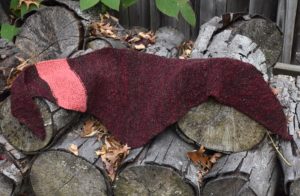 I like this technique with fingering and sock weight yarn, but it works in DK as well. Needle size? Whatever needles give you the fabric density you want. It’s perfect for leftover bits of yarn as well. I used a combination of dyed Merino/brown Corriedale yarn, with an accent partway through the scarf of a leftover skein of yarn I made using one single of Merino plied with one single of kid mohair, then hand dyed.
I like this technique with fingering and sock weight yarn, but it works in DK as well. Needle size? Whatever needles give you the fabric density you want. It’s perfect for leftover bits of yarn as well. I used a combination of dyed Merino/brown Corriedale yarn, with an accent partway through the scarf of a leftover skein of yarn I made using one single of Merino plied with one single of kid mohair, then hand dyed.
Many years ago – I guess it must be around 20 – I bought some fun dyed mixed roving and made this triangle scarf. I also used a crochet hook and scalloped the increase/decrease sides. It is my go-to scarf for all weathers!
Billow is an asymmetrical shawl where one color billows into another by increasing the number of fan & feather stitches. It is a nice effect and the last color has the most fan & feather. I pulled three skeins from my handspun. The yarn that would be closest to my neck was the softest, a blend of alpaca, Merino, and Louet Northern Lights roving, then Romney lambswool, and finally Wensleydale lambswool. I wasn’t sure at first how all these yarns would work together, but … magic!
Zilver uses a stockinette stitch section and a ridge section. I like the versatility of this pattern. If you want it longer, you just do another stockinette section (they are always the same number of rows) and another ridge section. The ridge section consists of a 4-row section that has successively more repeats as you work toward the end of the piece. As you work from the top to the point, the number of repeats of the ridge section increases by one more ridge (4 rows). The ridge sections provide a little texture and a simple lace design. It’s really easy to keep track of the knitting, and you can quickly do it all from memory. The pattern is written for fingering weight yarn, but I have also used lighter and slightly heavier yarn with great results.
I have already made two of these shawls, one from a variegated commercial yarn and one from a skein of handspun. The roving consisted of large sections in successive colors. I chain plied it to preserve these individual colors and knit it up into this shawl, with an extra ridge section. I really liked the self-striping appearance of the shawl.
Quill by Jared Flood
Quill is a great square Hap-style shawl pattern. I have knit the large version from walnut-dyed Merino fingering and have knit the small version from some Merino/cashmere handspun yarn. The large garter stitch center square is so nice for showing off your handspun’s texture. The edging is a lace border that is not too busy. It does take a while to work the lace edging, but it’s so worth the result. Whenever it is cold outside, I take one of my Quill shawls, fold it into a triangle, and snuggle into my chair with a good book.
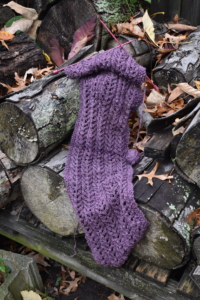 Birch Trees Scarf by Julia Marsh
Birch Trees Scarf by Julia Marsh
This pattern uses DK weight yarn. I have had some logwood-dyed Merino handspun just waiting for the right project. I spun the yarn on a Great wheel, and it has a fair amount of texture (well, unevenness, to be exact). I knew this pattern would be perfect for this yarn. The yarn is super soft and not overspun, so it will make such a nice cold weather scarf! I have two more skeins of yarn to knit into this project – I want to use it all up, so the scarf might be long! The lace pattern in this scarf is easy to remember, which is a plus for me because I keep misplacing my patterns!
I have a book called Folk Shawls by Cheryl Oberle. You can’t go wrong with any pattern in this book! I made the Kimono shawl from some of my earliest handspun. This handspun was Merino locks that I carded and spun many, many years ago. I made a feminine pullover from it that turned out so nice. Unfortunately, I turned out to be a little less feminine than my sweater, so I dismantled it and refinished the yarn. Cheryl’s Kimono shawl pattern was the perfect choice. The pattern is somewhat more complicated, so I followed her suggestion and made index cards for the pattern rows. I love cuddling up with this shawl in the winter while reading in bed.
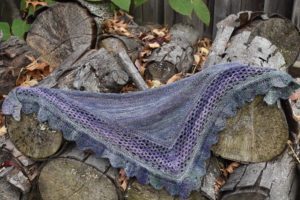 Aestlight Shawl by Gudrun Johnston
Aestlight Shawl by Gudrun Johnston
I have made the large and the small version of this shawl/scarf pattern. I made this in commercial yarn in the large version, in a purple wool/silk blend and a pink mohair blend for the honeycomb section. I used a violet/green/brown roving for the handspun, in fingering weight for the small version. When I make another handspun scarf, I’ll use a different color for the honeycomb section – it turns out very nice to have this break in the design.
Weaving with handspun
Don’t forget that handspun also makes a great woven fabric. All you need is a rigid heddle loom and a few reeds and you are good to go. It is fun to just grab several balls of yarn and do direct warping on these simple looms. You can get some very interesting vertical striping going and then either weave with more stripes in the weft or just pick a single color. I don’t bother with any fancy pick up patterns; just plain weave works so nicely with handspun. It is a quick and easy way to showcase your yarns. Once off the loom, don’t forget to properly full your piece. It will become extra cuddly if you do!
One example of rigid heddle weaving is a scarf I wove from very fine laceweight handspun using a 12-dent reed. I used two different skeins of yarn: Malabrigo Glitter for the weft and Inglenook Auburn for the warp.

The next example is a stole woven from DK-weight handspun and a mixed yarn made from Merino and kid mohair and then dyed. I used these two yarns in both warp and weft, in a somewhat random fashion.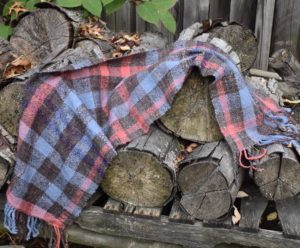
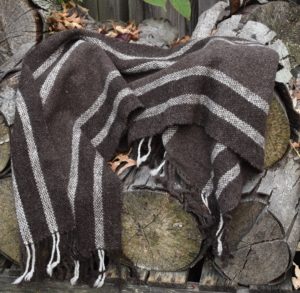 The last example is a stole woven from worsted to DK weight handspun in all natural colors. I set up a simple light/dark sequence and then wove with a single color weft, which brought out the stripes.
The last example is a stole woven from worsted to DK weight handspun in all natural colors. I set up a simple light/dark sequence and then wove with a single color weft, which brought out the stripes.
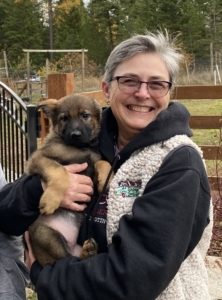
Sierra and her pup!
Sierra Polsinelli is a fiber artist way into her 60s. In retirement, she has decided to spin and weave her handspun (and other fibers) into scarves, shawls, and functional art. Her website has handspun, handknits, and handwovens: dakotadesigns.net.




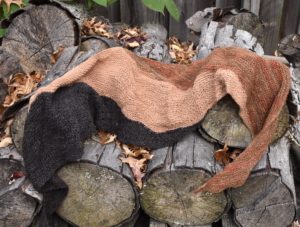
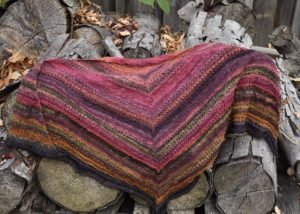
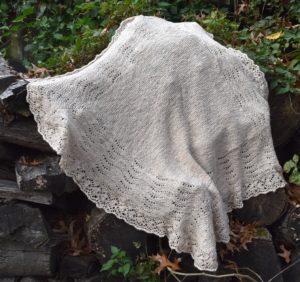
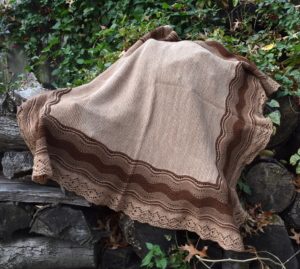
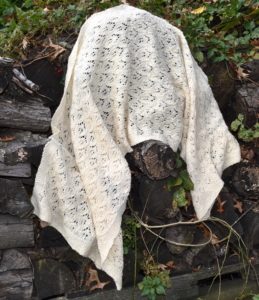


Leave a Reply
Want to join the discussion?Feel free to contribute!